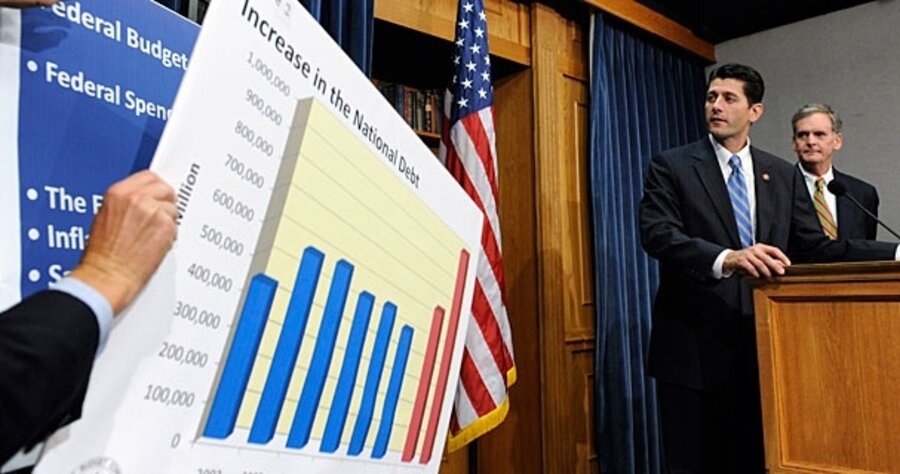What does a $1.2 trillion budget deficit look like?
Loading...
The US government’s budget deficit – its credit-card bill this year, if you will – could total a record $1.2 trillion, the Congressional Budget Office estimated last week. This raises the question: What’s the monthly payment?
If the sum were calculated as a traditional 30-year fixed-rate mortgage, Uncle Sam would have to write a monthly check for $6.7 billion. That would be enough to pay the mortgage on about 10 percent of the nation’s homes each month.
But if Uncle Sam had to finance the $1.2 trillion on a credit card – the way many small businesses do these days – the minimum monthly payment would be at least 2 percent of the balance, or about $24 billion a month. If the US Treasury had to pay the same interest rate as Joe the Borrower – a 14.9 percent annual percentage rate – it would take the government 79 months (6.6 years) to pay the money back – while still accruing an additional $686 billion in interest.
Of course, the government still carries a credit rating that allows it to pay considerably less interest than almost anyone else. Three-month US Treasury bills are yielding a historically low 0.30 percent rate while the 10-year note is at 2.48 percent.
However, some strapped borrowers only make minimum payments of about 2 percent of the original balance. It would take the taxpayers 50 years to pay off the deficit this way and they would rack up $1.94 trillion in additional interest, calculates Bill Hardkopf of LowCards.com, an online consumer service.
Given current interest-rate assumptions, the increasing deficit will cost an additional $18 billion in the first year. Because this money is added to the national debt, the Peter G. Peterson Foundation, which aims to increase public awareness of challenges facing the country, estimates the deficit would eventually cost $628 billion over 10 years.
“Today’s interest rates are favorable, but that could change and costs could balloon,” says Matthew Helm, manager of research & analysis at the foundation.
Another way to view the $1.2 trillion deficit is in terms of citizens and households. It works out to $4,000 per citizen, or $10,000 per household, according to Mr. Helm.
Yet another way to look at the massive deficit is in terms of what it would buy. For example, $1.2 trillion would cover the total annual cost of the education system in the US from kindergarten through college and still leave enough left over to buy six computers for every child under the age of 19.
That huge sum of money could also help children in another way. It would buy 20 gallons of milk for each child under the age of 19 for the next 15 years, according to Chris Galen, a spokesman for the National Milk Producers Federation in Washington.
But, most kids would probably rather have a computer game, such as a Wii, instead of all that milk. And they could all have one – the deficit could buy 4.8 billion Wiis or 6 billion “Guitar Hero” games – enough for nearly everyone on the planet.
Of course, not all parents will think that’s such a great idea. “Why not encourage your kids to truly exercise or learn to play a real guitar?” asked Joyce Greenberg, mother of a Wii-less 13-year-old girl, in New York City.
Perhaps on a less controversial note, the money could pay for gasoline expenses for all Americans for the next five years. “It would not only pay for a lot of gasoline, but it would also insure a lot of people without access to medical coverage,” says Geoff Sundstrom, a spokesman for AAA in Heathrow, Fla.
Some $2.4 trillion was spent on healthcare services in 2008, estimates the National Coalition on Health Care. But it also estimates that nearly 46 million Americans are uninsured.
“Various think tanks have estimated it could cost $100 billion to $120 billion to address the issue of the uninsured,” says Joel Miller, senior vice president at the coalition, which lobbies for healthcare issues.
But Mr. Miller says this number is likely to grow as the unemployment rate rises. For every one percentage point rise in unemployment, some 1.1 million people lose their healthcare coverage, he estimates. “So we are talking billions to cover entire families,” he says.
Even financial people dealing with large numbers for a living acknowledge the $1.2 trillion is hard to comprehend. Budget expert Stanley Collender recounts a recent dinner with George Soros, ranked last year by Forbes as the 99th richest person on the planet. “He told me a trillion is not a number he uses very much,” says Mr. Collender, a partner at Qorvis Communications in Washington.
It’s a number America needs to get used to, Collender says, because the budget deficit in the next fiscal year, 2010, is also likely to be more than $1 trillion. “It is virtually inevitable,” he says. “We will still be spending a lot of the stimulus package, spending money in Iraq and Afghanistan, and the economy will not have picked up much,” he explains.





